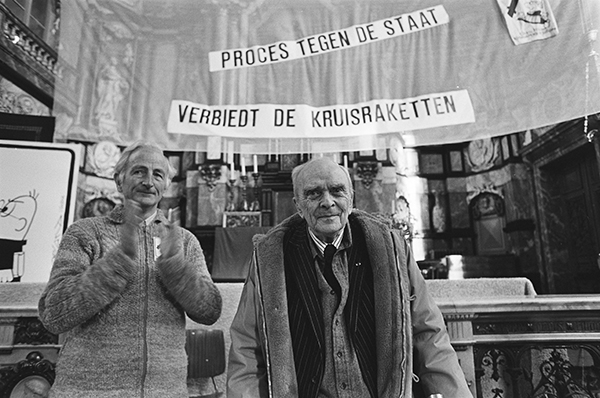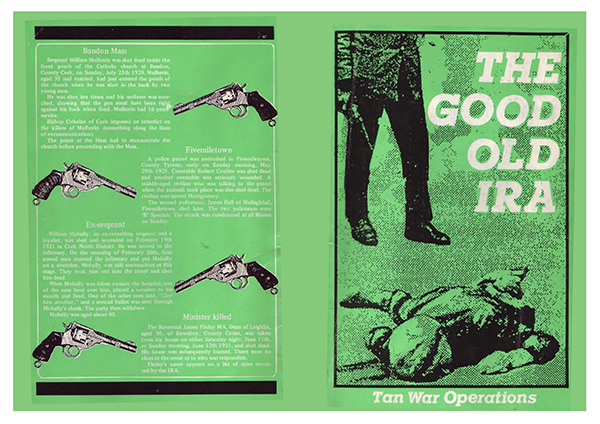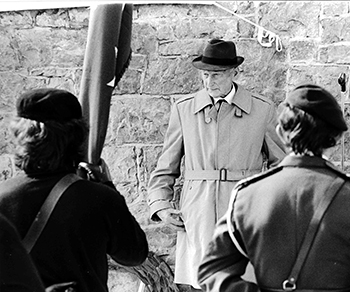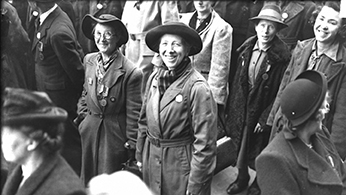THE ‘GOOD OLD IRA’—REMEMBERING REPUBLICAN VETERANS AFTER 1969
Published in Features, Issue 2 (March/April 2022), Volume 30By Jack Hepworth
In April 1972 it was estimated that there were some 32,000 living veterans of the ‘Old IRA’, Cumann na mBan and Na Fianna Éireann. Through the 1970s and 1980s, these veterans of Ireland’s revolutionary decade entered old age. When they died, local newspapers published reverential obituaries.
These heroic narratives sat uneasily with the Republic of Ireland’s complex relationship with the ongoing Northern Ireland conflict. In the North, a younger generation of militant republicans waged guerrilla war against British rule. Constituted mainly in the Provisional IRA, these republicans considered themselves successors to the revolutionary heritage of the ‘good Old IRA’, but the connection was contentious for the public, press, politicians and republican veterans alike. Against this turbulent backdrop, how did Old IRA veterans historicise their own pasts, and how were they remembered?
AGEING VETERANS
Republican veterans remained engaged in public life into their later years. These political interventions often invoked the revolutionary past, cognisant of the socio-political capital that veteran status endowed. Healthcare was a particular focal point for veterans. In 1973 the North Galway/South Roscommon Brigade complained that many of their members were not enjoying the full free hospital treatment to which they felt entitled. The medical issue was a recurring controversy. In 1987, veterans and local councillors in County Cork criticised the Southern Health Board for including Old IRA pensions in means-test calculations, contrary to Department of Defence regulations.
Yet despite the deference from which veterans seemed to benefit, Old IRA members were often disgruntled with the perceived apathy of the southern political establishment. After Dublin veterans’ calls for a National Day of Commemoration were rejected in 1974, the old brigade retaliated, declaring that senators would no longer automatically be invited to commemorations. The row endured into the 1980s. Veterans’ failure to invite then Minister for Defence Patrick Cooney to a commemoration dinner in 1984 revolved around differences in remembering the ‘Tan War’. Former IRA chief-of-staff and 1974 Nobel Peace Prize recipient Seán MacBride criticised the Defence Forces’ perceived ‘campaign … to recognise Poppy Day’.

Above: ‘THE CASE AGAINST THE STATE. BAN CRUISE MISSILES’—Seán MacBride at an anti-war meeting in Amsterdam in 1984. In the same year, the former IRA chief-of-staff and 1974 Nobel Peace Prize recipient criticised the Irish Defence Forces’ perceived ‘campaign … to recognise Poppy Day’.
Veterans’ commemorations and social occasions negotiated entangled memories of past activism and delicate political sensitivities. In 1986, amid further acrimony between veterans and the Republic’s establishment, veterans were banned from using Dublin army barracks for their annual dinner. Brig. Gen. Vincent Savino said that it would be ‘inappropriate’ for the officers’ mess to host the gathering: in past years veterans’ speeches had ‘politicised the occasion’.
THE ‘LAST LIVING LINKS’?
While the Republic’s political leaders appeared uneasy with the political agency of Old IRA veterans, members of the Provisional IRA were at pains to associate themselves with the last survivors of Ireland’s War of Independence. Fighting British rule in the 1970s and 1980s, Provisional republicans positioned themselves in succession to the republicans of the early twentieth century. In the early 1980s, Sinn Féin’s Education Department recommended that IRA prisoners familiarise themselves with the writings of Dan Breen, Tom Barry, Ernie O’Malley and Liam Mellows. Sinn Féin’s Publicity Department even produced a booklet, The Good Old IRA: Tan War operations, castigating commentators who drew distinctions between the republican operations of the 1920s and those of the Provisional IRA. Until 1986—when the Sinn Féin Ard-Fheis voted to drop Leinster House abstentionism—the Provisional movement frequently highlighted the support of Tom Maguire, the last survivor of the Second Dáil. Maguire later transferred his allegiance to Ruairí Ó Brádaigh’s Republican Sinn Féin. On the occasion of Maguire’s 100th birthday, Ó Brádaigh paid tribute to ‘the last living links with the heroic republican stand of the 1920s’.

Above: Sinn Féin’s Publicity Department’s The Good Old IRA: Tan War operations (1985), which castigated commentators who drew distinctions between the republican operations of the 1920s and those of the Provisional IRA
Yet many of those who celebrated the legacies of Ireland’s past revolutionary generation were irrevocably opposed to the Provisional IRA. Interviewed for Frank Burton’s book The politics of legitimacy (1978), a community activist in north Belfast’s Ardoyne district complained that ‘these Provos have ruined the ideal of Republicanism. They’re gangsters ruling with guns and if you say so you get your kneecaps blown off … The old IRA would never have allowed these hoods in the movement.’ This testimony reinforced a commonplace dichotomy between representations of a heroic, justified movement in the revolutionary decade and the ‘hoodlums’ and ‘gangsters’ of the Provisionals who supposedly sullied the name of republicanism and lacked community support.
Aside from the very considerable degree of support that the Provisional movement evidently enjoyed—witness the IRA’s sustained 30-year guerrilla campaign, and Sinn Féin’s electoral successes from 1981—this distinction of morality or commitment to a ‘clean war’ between the ‘good Old IRA’ and the Provisional IRA since 1969 was flimsy at best. By 1921 the IRA and Crown forces were shooting civilians more often than they were shooting each other. The War of Independence included its own litany of massacres, including nakedly sectarian attacks on Protestant civilians. In County Cork between 1920 and 1923 the IRA shot over 200 civilians, of whom over 70 (36%) were Protestants. The horrors of the Kingsmill massacre of 1976, when ten Protestant workers were shot dead, or the Enniskillen bombing of 1987 were not the first republican outrages.
‘A VERY COLOURFUL ERA’: OBITUARIES, ORATIONS AND COMMEMORATIONS

Above: Commandant Tom Maguire, the last survivor of the Second Dáil, at the unveiling on 21 April 1985 of a plaque on the site of Tuam workhouse, where six IRA Volunteers were executed by Free State forces on 6 January 1923. Until 1986—when the Sinn Féin Ard-Fheis voted to drop Leinster House abstentionism—the Provisional movement frequently highlighted his support.
For those veterans and their relatives who regarded the Provisional IRA campaign as a legitimate continuation of the revolutionary decade, funerals and commemorations provided an opportunity to highlight perceived hypocrisy in the southern political establishment. At the annual Crossbarry commemoration in west Cork in 1990, guest speaker Donall Ó Faoláin—sharing a platform with republican cleric Father Paddy Ryan—claimed that many 1920s veterans did not approve of the distinction implied in ‘Old IRA’. Ó Faoláin said that many War of Independence veterans considered the Provisional IRA campaign ‘a continuation of the same struggle’. Seán C. MacAoidh of Fintown, Co. Donegal, made a similar intervention in September 1988, writing to the Donegal News on the death of his uncle, IRA veteran Willie Durnion:
‘My pride is tinged with sadness and anger at the hypocrisy of Irish society in general, and Irish politicians in particular … If Willie Durnion were fighting today for the same principles for which he shouldered the gun during his youth … some dubious charges would be trumped up against him … It is time to end the hypocrisy and admit there is a war on … Let us honour our dead kin, but let us leave a legacy of peace, justice and freedom to future generations.’
Veterans’ obituaries tended towards hagiography by association, as individuals would often be remembered by reference to those notables with whom they had served. General Seán Boylan from Dunboyne, Co. Meath, was remembered not only for having been OC 1st Eastern Division and Sinn Féin’s director of elections in 1918 but also for having been a ‘close friend of Michael Collins’. Jim Taylor of Derry died in 1990 aged 90, having been involved in Peadar O’Donnell’s flying column, and was recalled as listing his 1919–21 service medal among his proudest possessions.
Remembrance typically ascribed certain characteristics to the generational cohort now departed. Obituaries constructed and reformulated popular memories of veterans as part of a cohesive political generation. Particular character traits were assigned to the men who had fought the war before retiring to quiet, unshowy lives in rural Ireland, contributing to local communities with quiet dignity. Typical of this type was the obituary of Bill Flatley of Ballyhaunis, Co. Mayo, ‘whose modesty was such that his endeavours in the cause of Irish freedom were overshadowed by the simplicity which he attached to even his most daring exploits’. Modesty and quietness in old age were juxtaposed against the daring of Flatley’s younger years.
Vagueness and omission in obituaries of veterans of Ireland’s revolutionary decade is perhaps unsurprising. The Civil War was typically ignored or referenced obliquely. Newspaper obituaries and funeral orations seldom referred to the splits that divided the IRA after the Treaty. The factionalism, which unfolded especially acutely in Donegal, Limerick and Dublin, was conspicuous by its absence from these tributes. Typically, veterans were remembered to have lamented the Civil War and eschewed its violent binaries. Of Bill Flatley it was said: ‘He always maintained that the Civil War which followed should never have happened, and though he accepted the Treaty he never took any part in the Civil War, refusing to take up arms against fellow Irishmen’. Similarly, Paddy Whelan of Mohill, Co. Leitrim, was remembered on his death in 1971 for having worked ‘unceasingly to unite his old comrades’ after the Civil War, and his role in assembling the Leitrim Old IRA committee was a subject of particular praise.
In obituaries of republican veterans some newspapers refused to mention the Civil War, instead referring euphemistically to ‘the emergency’. On the rare occasions where it merited mention in a remembrance, a veteran was typically recalled as a conciliatory figure working to unify the warring factions. Many veterans, such as Peter Larkin of Craughwell, Co. Galway, were said to have demobilised immediately when the movement split over the Treaty. With the Tan War concluded, heroic figures would hardly stain their reputation in the shameful internecine conflict that followed. Of Larkin it was written: ‘He was the first to step out and say that he was utterly opposed to the Treaty, but emphasised that he would never fire a shot against a fellow Irishman. As he grew older he was very glad that he had taken that decision.’
Emphatic opposition to the messy and corrupting business of party politics coloured the public memory of veterans who had joined neither Fianna Fáil nor Fine Gael when their military days were done. When Peter Flannery of Castlebar, Co. Mayo, died aged 83 in September 1980, the Connaught Telegraph described him thus: ‘After the Truce, when peace was restored and the rat-race for unearned compensation, pensions and military honours commenced, the late Mr Flannery, a straightforward, upright, sincere Irishman, became disgusted and disillusioned with Irish politics and would have nothing further to do with them’.
Yet the squeamishness that usually elided allegiances during the Civil War by no means obscured or prettified the very real military involvement of deceased veterans. On the contrary, there were usually explicit references to military escapades. For example, when Captain Con Cregan from County Limerick died in Philadelphia in 1976, his part in the attack on Kilmallock RIC barracks was recalled in great detail. James Quinn from Nenagh, Co. Tipperary, was said to have taken ‘an active part in many engagements in the fight for independence’ as a member of the North Tipperary Brigade. These engagements were described in heroic terms, imbued with the sense that they had been part of a campaign that was both justified and ultimately successful. Thomas Kennedy of Athenry, Co. Galway, was remembered for taking part in the burning of Bookeen barracks, during which he had the ‘narrowest escape from death by enemy fire’. Patrick McNulty of Castlebar, Co. Mayo, was celebrated for ‘narrowly escaping death’ during the Cloonkeen ambush of May 1921.
THE ‘BOYS’ OF THE OLD BRIGADE?

Above: Máire Comerford with other Cumann na mBan women c. 1920. After her death in 1982, she was remembered for having served as Frank Aiken’s driver rather than for her own remarkable life.
The gendered dimension of veterans’ obituaries highlighted the commonplace configuration of republican women in supporting and ancillary roles. May Cotter of Bantry, Co. Cork, was named as a former member of Cumann na mBan who transmitted arms and intelligence to Erskine Childers when he was billeted in west Cork during the Civil War. Máire Comerford from Rathdrum, Co. Wicklow, was remembered for having served as Frank Aiken’s driver and for carrying despatches for him. Yet Comerford’s own remarkable life included a spell of imprisonment in Mountjoy, where she embarked on a hunger strike, and subsequent brushes with the law as an outspoken supporter of the Provisional IRA in her later life.
Women’s roles were closely identified with the juxtaposition of domesticity during conflict: Peg Bowles of Clogheen, Co. Cork, was noted for having concealed guns in the house during the Civil War, a crime for which she was initially sentenced to death, later commuted to life imprisonment. Margaret Walsh of Threecastles, Co. Kilkenny, died in 1971. She had been a founder member of C Company in 1917 and was credited with giving hospitality to men on the run. ‘An admirer’ quoted in her obituary claimed that it was Walsh’s bicycle that ‘bore Mick Dermody to death and immortality in Friday street on that February morning 50 years ago … The least worried of all [about this becoming public] was Mrs Walsh herself. That was her disposition … Her passing brings to an end a link in a very colourful era in our country’s history.’
CONCLUSION
Through the 1970s and 1980s, the legacies of Ireland’s revolutionary decade were hotly contested. The contemporary context of a conflict raging in the North—and a Provisional republican armed struggle to which many in the Republic were strongly opposed—made commemoration controversial. In later life, Old IRA veterans were often at odds with a Dublin political establishment which they regarded as forgetting their sacrifice of decades past. Some supported the Provisional republican campaign as a continuation of their own struggle, but others were irrevocably opposed.
The local press, establishment politicians and churches in the Republic of Ireland were broadly hostile to the Provisional republican movement during these decades, yet this did not prevent pervasive celebration of the veterans of the War of Independence. On the contrary, obituaries of Old IRA veterans celebrated ‘the boys of the old brigade’ as founders of the nation belonging to a unique historical generation. Many who baulked at being seen to offer succour to the Provisionals had no such misgivings about celebrating and commemorating the ambushes of Tom Barry and Dan Breen.
Yet obituaries also negotiated the pain and losses of the revolutionary decade, encapsulated especially in the largely unspoken trauma surrounding the Civil War of 1922 and 1923. As the final chapter in the decade of centenaries draws near, it remains to be seen whether the distance of time and generations will enable a fuller reassessment of those events.
Jack Hepworth is Canon Murray Fellow in Irish History at St Catherine’s College, Oxford.
Further reading
M.E. Daly & M. O’Callaghan (eds), 1916 in 1966: commemorating the Easter Rising (Dublin, 2007).
R.S. Grayson & F. McGarry (eds), Remembering 1916: the Easter Rising, the Somme and the politics of memory in Ireland (Cambridge, 2016).
K. Griffith & T.E. O’Grady, Curious journey: an oral history of Ireland’s unfinished revolution (London, 1982).
I. McBride (ed.), History and memory in modern Ireland (Cambridge, 2001).
















